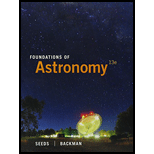
How many precession periods are in one cycle of Earth’s axis inclination variation? In one cycle of Earth’s orbit eccentricity variation? In the time span shown in Figure 2-11b, how many periods or fractions of periods did the Earth’s axis precess, nod, and Earth’s orbit change shape? Of the three periods, which is likely to have the most effect on the changes shown in Figure 2–11?
The number of precession periods in inclination change of one cycle of Earth’s axis, eccentricity variation of Earth’s orbit, and number of periods or period fractions of precision of Earth’s axis, nod, and change in shape of Earth’s orbit in time span given in figure 2.11b and also identify which one has more influence on changes plotted in figure 2.11.
Answer to Problem 14P
The number of precession periods in inclination change of one cycle of Earth’s axis is
The number of periods of eccentricity variation of Earth’s orbit is
Number of periods for a cycle of precision of Earth’s axis over time span given in 2.11b is
Number of periods for a cycle of nod over time span given in 2.11b is
Number of periods for a cycle of change in shape of Earth’s orbit in time span given in figure 2.11b is
Explanation of Solution
The precession period of Earth is around
Write the equation to find the number of precision period in a complete cycle of tilt change of Earth’s axis.
Here,
Time taken to complete one complete cycle of eccentricity variation of Earth’s orbit is almost
Write the equation to find the number of precision period in one complete cycle of eccentricity variation of Earth’s orbit.
Here,
The time span shown in figure 2.11b is
Write the equation to find number of precession periods or period fractions during
Here,
Write the equation to find number of nod periods or period fractions during
Here,
Write the equation to find number of periods for change in shape of Earth’s orbit or period fractions during
Here,
Conclusion:
Substitute
Substitute
Substitute
Substitute
Substitute
Figure 2.11 plots the temperature variation in Earth over many years. The prime important reason for seasons is the tilting of axis of Earth. So the changes in figure 2.11 is more influenced by
The number of precession periods in inclination change of one cycle of Earth’s axis is
Want to see more full solutions like this?
Chapter 2 Solutions
Foundations Of Astronomy, Loose-leaf Version
- Look at the view from Earth on March 1 in Figure 2-9, shown here. Is the view from Earths nighttime side or daytime side? How do you know? Which asterism or constellation is shown in this image?arrow_forwardStudy Figures 4-11 and 4-16 and describe the phases that Venus would have displayed to Galileos telescope if the Tychonic universe had been correct. Figure 4-11 Tychos model of the Universe retained the first principles of classical astronomy; it was geocentric with the Sun and Moon revolving around Earth, but the planets revolved around the Sun. All motion was along circular paths. Figure 4-16 (a) If Venus moved in an epicycle centered on the Earth-Sun line (see Figure 3b in the Chapter 2 Concept Art: An Ancient Model of the Universe), it would always appear as a crescent. (b) Galileo observed through his telescope that Venus goes through a full set of phases, proving that it must orbit the Sun.arrow_forwardSuppose you are on a strange planet and observe, at night, that the stars do not rise and set, but circle parallel to the horizon. Next, you walk in a constant direction for 8000 miles, and at your new location on the planet, you find that all stars rise straight up in the east and set straight down in the west, perpendicular to the horizon. How could you determine the circumference of the planet without any further observations? What is the circumference, in miles, of the planet?arrow_forward
 Foundations of Astronomy (MindTap Course List)PhysicsISBN:9781337399920Author:Michael A. Seeds, Dana BackmanPublisher:Cengage Learning
Foundations of Astronomy (MindTap Course List)PhysicsISBN:9781337399920Author:Michael A. Seeds, Dana BackmanPublisher:Cengage Learning
 Stars and Galaxies (MindTap Course List)PhysicsISBN:9781337399944Author:Michael A. SeedsPublisher:Cengage Learning
Stars and Galaxies (MindTap Course List)PhysicsISBN:9781337399944Author:Michael A. SeedsPublisher:Cengage Learning AstronomyPhysicsISBN:9781938168284Author:Andrew Fraknoi; David Morrison; Sidney C. WolffPublisher:OpenStax
AstronomyPhysicsISBN:9781938168284Author:Andrew Fraknoi; David Morrison; Sidney C. WolffPublisher:OpenStax
 Stars and GalaxiesPhysicsISBN:9781305120785Author:Michael A. Seeds, Dana BackmanPublisher:Cengage Learning
Stars and GalaxiesPhysicsISBN:9781305120785Author:Michael A. Seeds, Dana BackmanPublisher:Cengage Learning





